Donald Trump’s Strangest Bedfellows: Part 12
The Way We Weren’t
This is Part 12 of a blog series titled “Donald Trump’s Strangest Bedfellows.”
Although each entry in the series has some information and commentary
that can be of interest “standing alone,” each builds on information,
concepts, and commentary introduced in earlier entries in the series,
and thus it is most effective to read the material sequentially from the beginning.
Click here to go to the first entry in the series, Part 1
At the end of each entry you will find a link to the next part of the series.
I never did get around to seeing the 1973 Barbra Streisand/Robert Redford The Way We Were movie. But anyone old enough to have been around during that era surely remembers the classic theme song by the same name, sung by Barbra. It was a huge hit at the time, named the Billboard Magazine top song of 1974, and “went platinum” eventually, selling over 2 million copies. It has long since become a cultural “pop standard” song.
Its popularity can in part be attributed to Streisand’s usual powerful delivery, and the haunting melody. But I’m suspicious it is also in part because of the poignant lyrics…that many listeners can identify with. Starting with the opening two lines:
Mem’ries light the corners of my mind
Misty water-colored mem’ries of the way we were
Why “water-colored” and “misty”? Because even a harsh scene like a broken-down house or an auto junkyard, if rendered by a painter in pale water colors and as if seen through a watery mist—would lose all its harsh edges and jarring details! It can even take on a beauty of its own…especially if, as seen in a misty, water-colored memory, that run-down house has the gentle representation of some beloved person like a grandma standing on the porch.
A while back, I found a long-lost 1952 photo of my grandparents’ northern Michigan farmhouse in a jumbled box of old photos, the only photo I have of it. I probably hadn’t seen that photo since my childhood! My memories of visiting that house in that year, when I was six years old, have long included sitting in a porch swing, on a wide, wrap-around porch WAY high off the ground, that was big enough to comfortably seat my whole extended family on porch chairs to enjoy the gentle coolness of a summer evening and chat. The porch was so high I couldn’t have safely jumped down from it, and thus I have always pictured railings all around it to keep me safe. To get down to the yard to go catch fireflies with my older siblings on a 1950s summer’s eve, I would have needed to scamper down the wide steps leading down from the front of the porch, that were so clear in my mem’ries.
If asked to describe the building, I would have seen in my mind’s eye a cheerful, brightly painted (probably white), expansive two story house (my bedroom when I visited was upstairs looking down over that porch). My misty mem’ry of Grandma and Granddad’s house looks very much like this farmhouse I found just now with a Google image search.

In fact, adding the softening “watercolor effect” to my mem’ry (via photoshopping…) leaves what’s long been in my mind something more like this:
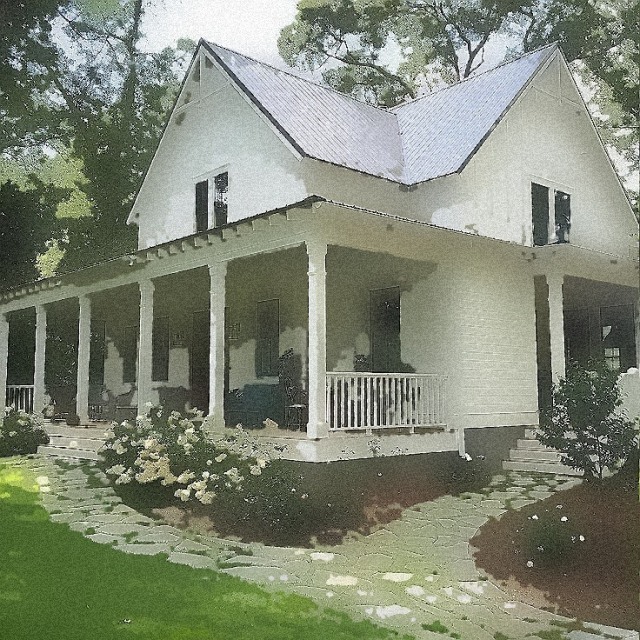
Imagine my shock when I found the photo of the actual down-at-the-heels old house (probably built in the 1920s or so) as it looked in the 1950s.
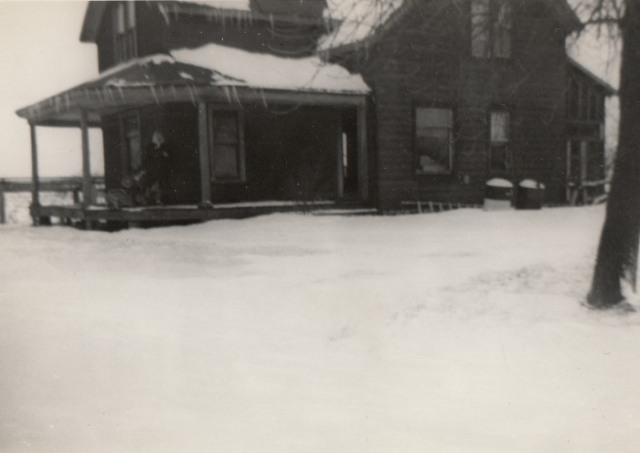
After seeing this photo, I guess it was indeed two-story, and sprawling a bit, and there is the upstairs front window of the bedroom I remember looking out. But that is NOT a cheery building! It is dark and bleak. That’s probably my Grandma Irene on the porch—which was certainly not nearly big enough to seat my family comfortably. There are no railings and no steps and no porch swing at all, and I could easily have jumped down from that porch to the yard even as a little girl.
I like my misty, water-colored mem’ries of the farmhouse, better than the vastly inferior reality. I have similar misty mem’ries of other things from my “Fifties Happy Days” youth, that all too often have to be readjusted when I see real photos of what it was REALLY like. I think most Baby Boomers have similar misty mem’ries of their own childhood and teen years. Nothing wrong with that, when it is involved in little features of our own family nostalgia.
The problem comes when we utterly refuse to admit that some things we think we remember are incorrect, including practically glorified memories about the wider society and culture of the time, even when faced with reality. And when we pass our incorrect inflated memories on to later generations, who may end up basing “real world” decisions in the 21st century on our claims.
There are a lot more important factors about the 1950s than the look of my Grandma’s farmhouse, that have been filtered through water-colored mem’ries. Or, in some cases, filtered through outright efforts of certain people and groups who deal in misinformation…or disinformation.
Did, for instance, the Warren Court decisions in 1962 and 1963 regarding “government-guided” prayer and Bible reading and “religious exercises” in schools have a devastating effect on society? Did those rulings lead to most families and youth of the time being drastically degraded almost overnight from fine, upstanding examples of Christian Living as they had been in the 1950s and before, to degenerate hedonists? All because those decisions “kicked God out of the schools” and implied to Him that no one wanted His interference anymore?
To read the claims of many modern evangelicals, that we need to “Make America Christian Again” (along with making it militarily and economically Great again) one would think that indeed, the Warren Court was a tool of the Devil to bring about the near-destruction of an almost idyllic US society. And only a coalition between Donald Trump and his Strange Bedfellows can restore the Land to its former glory.
Let’s part some of the mists shrouding the reality of the Happy Good Old Days, look at some actual photos and documentation, and see what we might see.
There seems to be a prevalent conviction among the nostalgic that the nature of marriage and family life in the 1950s and early 60s lined up throughout most of society with what you see on re-runs of old TV shows of the time. There is a particular nostalgia for the warmth of the marriage shown on I Love Lucy, and the patriarchal benevolence and respect for the dignified family role of fathers shown on Father Knows Best.
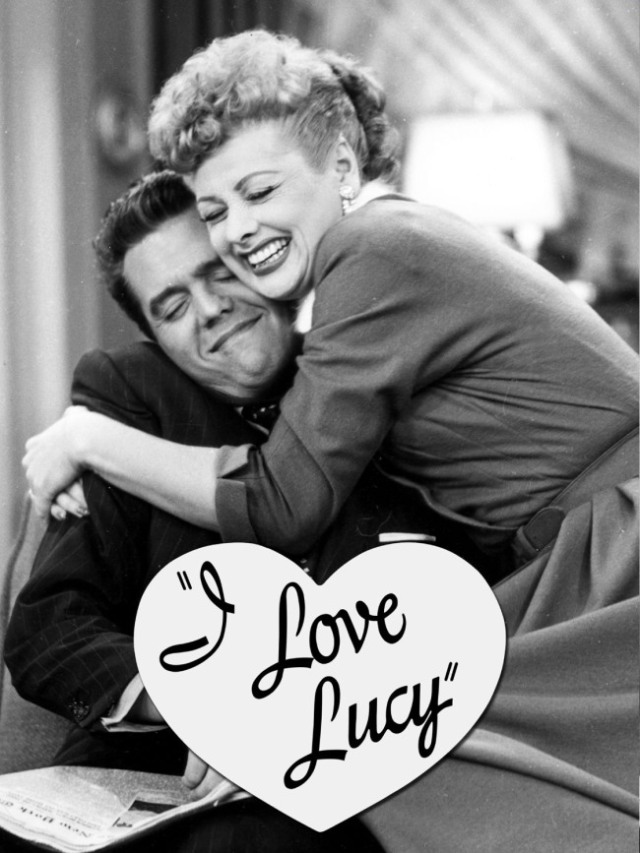
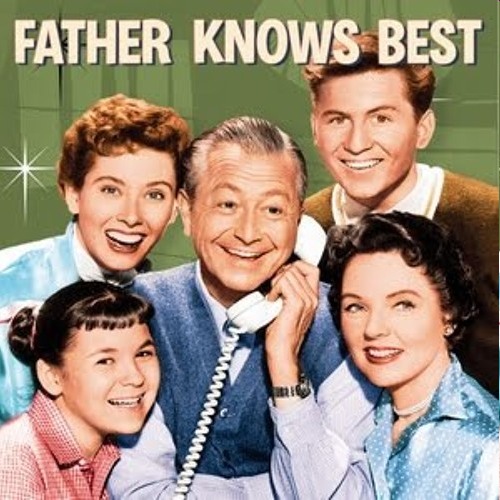
So let’s take a brief look at these two upstanding/outstanding examples of what family life must have been like back in the heyday of when America was Christian and Great.
From the time the new I Love Lucy show hit the airwaves in 1951, Lucy and Desi were The American Ideal, the role models, of a loving couple. On TV, and in real life. EVERYBODY loved Lucille Ball. Especially, it seemed obvious, her doting husband of a decade (who played her fictional husband on the show), Desi Arnaz. The whole nation practically shut down every week as the latest episode of I Love Lucy was broadcast. Especially the episode that was aired on the date on which Lucy gave birth, in real life, to the couple’s second child, Desi Arnaz, Jr.
The episode in which Lucy gives birth [to the baby called on the show “Little Ricky”], “Lucy Goes to the Hospital”, first aired on January 19, 1953, which was the day before the inauguration of Dwight Eisenhower as President of the United States. To increase the publicity of this episode, the original air date was chosen to coincide with Lucille Ball’s real-life delivery of Desi, Jr. by Caesarean section. “Lucy Goes to the Hospital” was watched by more people than any other television program up to that time, with 71.7% of all American television sets tuned in, topping the 67.7 rating for the inauguration coverage the following morning. [Source]
The couple and their sweet little daughter (born just weeks before the first episode of the show) and young son were featured regularly on covers and in photo spreads in national magazines—and even comic books—giving the public a glimpse of the ideal family life they could aspire to.
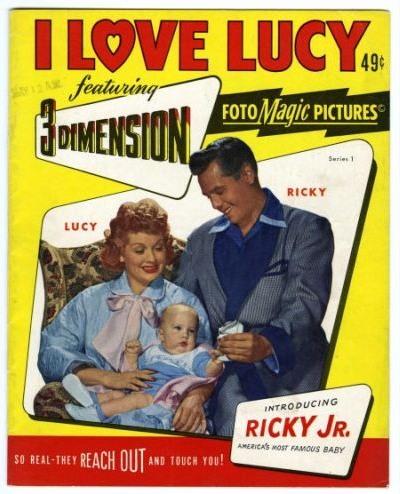
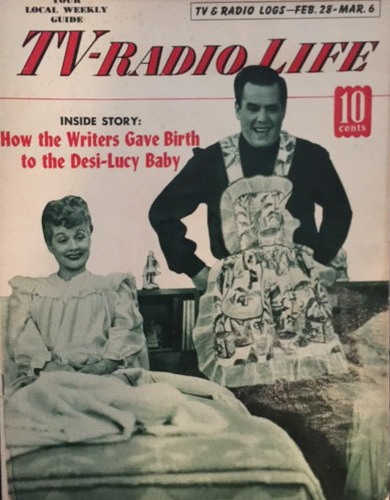
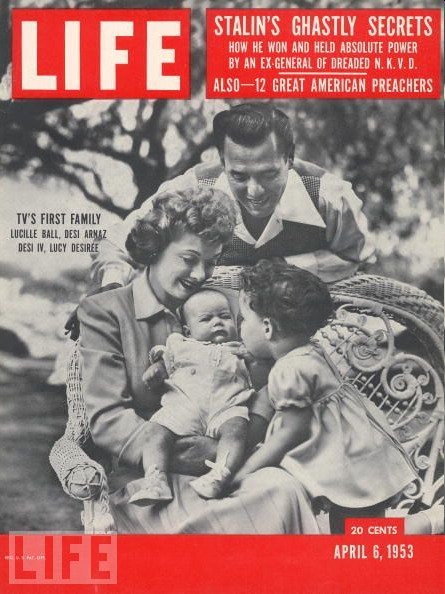
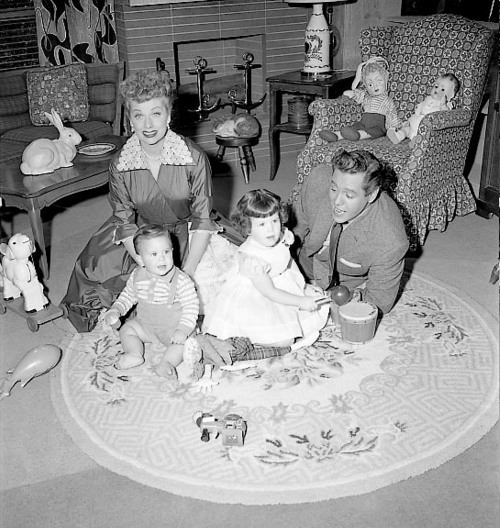
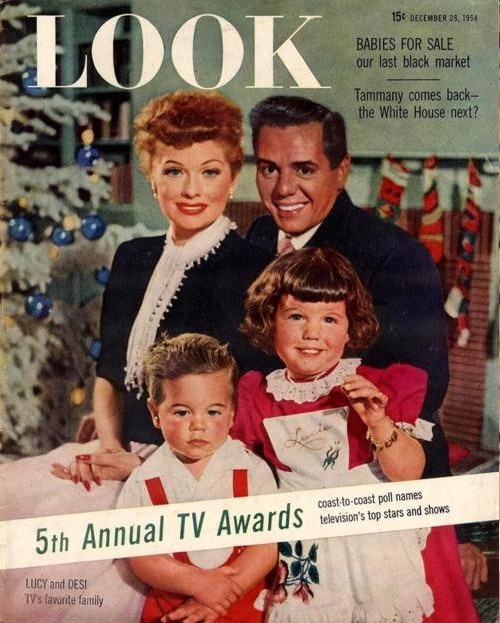
Except…everything in those pictures was already a misty, water-colored façade.
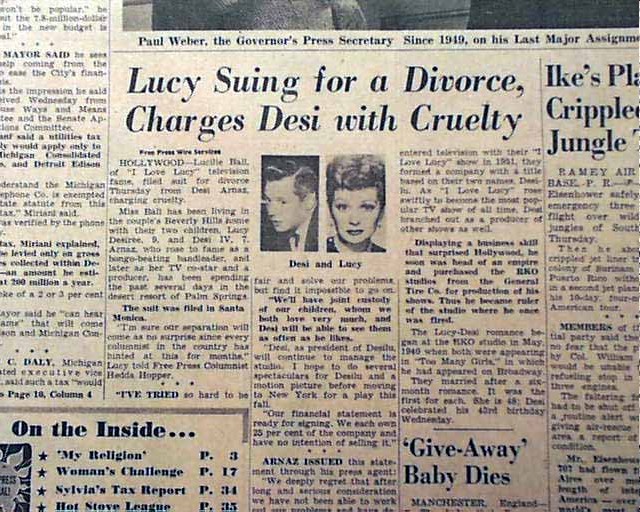
On March 3, 1960, a day after Desi’s 43rd birthday (and one day after the filming of Lucy and Desi’s last episode together), Ball filed papers in Santa Monica Superior Court, claiming married life with Desi was “a nightmare”and nothing at all as it appeared on I Love Lucy. On May 4, 1960, just two months after filming that episode (the final episode of The Lucy-Desi Comedy Hour), the couple divorced. [Source]
The fictional couple you saw on the show were not a “reflection” of the real home and family life of the famous couple, as you might think from seeing all those magazine spreads. The life displayed on the show was pure fiction. From the earliest years of their marriage, in 1941, Desi Arnaz had been a confirmed womanizer, and by the time of the I Love Lucy show his private life was one never-ending round of drinking, gambling, and women when not “on set” filming the show.
People Magazine bio of Desi and Lucy 1991
[A potpourri of comments by people who knew them:]
Jim Bacon, veteran Hollywood reporter for the Associated Press: The big problem with their marriage was that when Desi would get drunk, he was wild. If he was out carousing, he wouldn’t call in one whore, he’d call in 18. One night when I was with him in Palm Springs, he didn’t do anything but sit on the floor naked and sing “Babaloo” with all these whores around.
Bob Weiskopf [screenwriter and producer]: Basically, Desi’s attitude was, “What the hell’s the matter? I love her. When I go out with women, they’re usually hookers. Those don’t count.”
Jim Bacon: Lucy put up with it quite a bit, but then it just became too embarrassing. Especially when he got arrested on Hollywood Boulevard. That was sometime in the ’50s. The cops picked him up, drunk, standing in front of this whorehouse, singing Cuban songs.
Bart Andrews [author of books about Lucy]: She told me that by 1956 it wasn’t even a marriage anymore. They were just going through a routine for the children. She told me that for the last five years of their marriage, it was “just booze and broads.” That was in her divorce papers, as a matter of fact.
Keith Thibodeaux, who played Little Ricky on the I Love Lucy show: [At their home] there was always tension. One time Desi Jr. and I were playing in the backyard, and they were in the guest house. We heard a lot of loud arguing and cursing and glass shattering and screaming, and we were scared. Desi Jr. turned to me and said, “There they go again.” I was about 9,10 years old. [Source]
If the family life on I Love Lucy didn’t really reflect the life of the actors in the real world of the 1950s, how about the family life of “Jim Anderson,” actor Robert Young’s alter-ego on the Father Knows Best show (1954-1960)?
When reminiscing about how godly and wonderful the society of the 1950s was, lots of folks with roots in that era will point to their memories of Father Knows Best as an example of how things were, and how far we’ve come from that ideal.
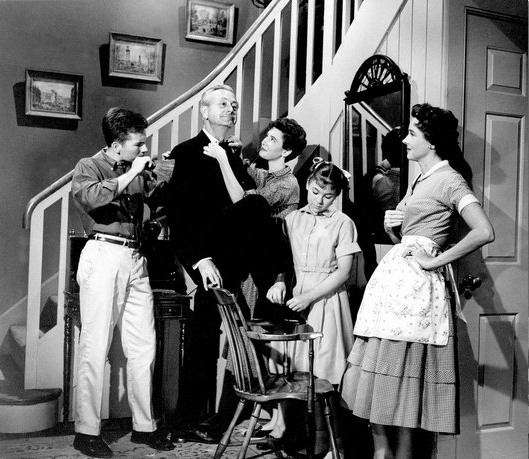
Jim and Margaret Anderson and their children, Bud, Betty, and little Kathy were touted back at the time as the perfect models for us all. And continue to be touted by some folks clear into the present as the perfect models to go back to, as part of Making America Great again, restoring “True Family Values.”
The problem is, Jim, who supposedly Knew Best, and his wife and offspring weren’t a family of the ‘50s. They were fictional characters! Invented by writers in Hollywood.
They weren’t the “typical” family of the day. They were what I’ve come to call a Disneyfied version.
The show began in 1954, just a year before Walt Disney introduced the nation to his own “pseudo memories”…misty, water colored mem’ries…of his childhood hometown.
Mainstreet USA as seen in Disneyland and the later Disney parks such as this one in France…

…was created as an idealized version of Walt’s childhood hometown, Marceline, Missouri. A VERY idealized version. For here is the unvarnished, un-water-colored, un-mistied up Marceline of the period when he lived there.

The Disney Imagineers who designed Main Street, USA, were trying to create a popularized Utopian environment. The word “Utopia” was invented by author Thomas More for his 1516 book titled Utopia, by combining the Greek words for not and place—it is “no place.” A “Place that Never Was.” The Disney version was based on Walt’s pseudo-memories of a Place that Never Was.
And this is surely true of the fictional Anderson Family—it was the Family That Never Was.
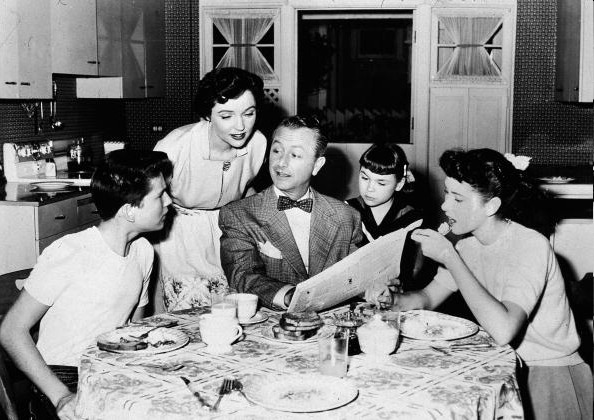
Because the REAL people who populated the screen sets for the show during its run from 1954 to 1960 were nothing like the Andersons. Elinor Donahue (daughter “Betty”) and Jane Wyatt (wife “Margaret”) managed to escape major issues. But the stories of the rest of the cast make it clear that the show wasn’t reflecting real life.
Robert Young (“Jim”): Young suffered from alcoholism and depression off screen during the show’s run. He had a nervous breakdown in 1966 and it took him nearly 4 years to recover. He attempted suicide in 1991.
Lauren Chapin (“Kathy”—called “Kitten” on the show by her dad): In real life, Lauren, born in 1945, had a hellish home life, as briefly described in this review of her 1989 autobiography:
An astounding 20-year drug trip through hell, riveting from first word to last. In the Fifties and Sixties, Chapin was famous as Robert Young’s snippish and pesty younger daughter Kathy on Father Knows Best. Her real-life mother and father separated because of her mother’s alcoholism, and mother remained with Lauren and her two brothers. Mother was a vicious harpy and life with her sheer hell. But even before the divorce, Lauren as a three-year-old was sexually abused by her father, who fondled her while watching TV. Then at seven Lauren landed her TV goldmine job and, with her child actor brother, supported the family. But life with mother was a raging inferno and at 11 Lauren ran away to live with her remarried father and got court protection from her mother. However, Dad was soon up to his old TV tricks with his aging daughter and for years disgusted and terrified her with his demands.
So Lauren ran off again, to marry a kid she didn’t love, then was taken in by a supercharming pimp hairdresser/drug-dealer, who got her hooked on heroin and had her turning tricks for $1000 each. Pimp Eddie was soon breaking her ribs and kicking her apart for not earning enough–and the rest of Lauren’s tale is simply hair-raising, with vile, nutty killer Eddie and his .375 Magnum being the easy part. [Source]
Intermixed in all that, she suffered 8 miscarriages and two serious attempts at suicide. The first was a failed attempt at hanging herself on the rack in her clothes closet in her teen years. The second:
“While on drugs one night, she sought to exorcise her demons with a meat cleaver and was found by the police “wandering down Hollywood Boulevard, delirious and with my left hand almost severed. They took me to the hospital and managed to save my hand, but I have no feeling in it.” [Source]
Early on she may have been “turning tricks” for $1000, but that didn’t last long:
At first, men would pay handsomely to sleep with “Kitten.” Eventually, she descended to working the street, servicing 30 to 40 men a night for as little as $5 a trick. [Source]
And the money she earned from her stint on Father Knows Best?
By the time she was eligible for her $90,000 TV earnings, held in trust, her mother, an alcoholic suffering from TB, had sued her for the money. Lauren settled the case out of court and emerged with just $19,000. [Source]
Gratefully, Lauren Chapin had a “religious conversion” experience in 1979 that turned her life around, and is reported to be doing well now at age 71.
Billy Gray (“Bud”): Billy was born in 1938, so when the show ended he was about 22. In 1962 at age 24, Billy was arrested and sent to jail for a while for marijuana possession. (He is reported to have publicly admitted to using weed heavily since age 14.) Although he was never again in problems with the law for drug matters, that single incident plagued him for years in terms of getting other acting roles.
Billy (now 79 years old) was probably the most honest critic of the show, insisting in interviews in later years that it was NOT either a good role model for families, nor an accurate reflection of family life and society in general in the 1950s. Here are some excerpts from a 1983 interview with Billy:
I wish there was some way I could tell the kids not to believe it. The dialogue, the situations, the characters, they were all totally false. The show did everyone a disservice. The girls were always trained to use their feminine wiles, to pretend to be helpless to attract men. The show contributed to a lot of the problems between men and women that we see today. . . . I think we were all well motivated, but what we did was run a hoax. ‘Father Knows Best’ purported to be a reasonable facsimile of life. And the bad thing is, the model is so deceitful. It usually revolved around not wanting to tell the truth, either out of embarrassment, or not wanting to hurt someone. If I could say anything to make up for all the years I lent myself to (that), it would be, ‘You Know Best.’ [Source]
But is it fair to expose what was going on (behind closed doors) in just those particular settings? Perhaps the people involved weren’t living up to the fictional depiction of family life in the shows. But was that just because they were immersed in the “entertainment industry,” which had long had a bad reputation that didn’t line up with “respectable society”?
From 1955 through 1964, I lived in a small town in northern Michigan named Traverse City. We had moved from Ohio to Traverse just as I went into the fourth grade. Virtually everyone else in my grade school had lived there since birth. As with many such small towns, it is hard for “outsiders” to be integrated into the community. Thus even after living there for eight years, I never felt as if I “belonged.” And thus I never knew much about the “home lives” of the kids I saw every day at school.
My own extended family had many “issues” and relationship problems, everything from alcoholism, divorce, and adultery to mental illness. But since I was seldom around the families of my classmates, I developed a perspective that my family must be unique…and all these others were “picture perfect.” They were, in essence, all living in Richie Cunningham’s Happy Days world!
After I moved away to college, and never went back to visit any of those folks, that perspective never changed. Until recently. Facebook is an amazing resource for getting in touch with the past! Just in the past year, I’ve gotten back in touch with three women who had been in my classes in Traverse in grade school and high school whom I hadn’t heard from since the 1960s. We’ve swapped memories and stories.
I was open about my own nuclear and extended family’s struggles back then. And one of the women startled me when she described attending the reunions of our high school class, the most recent our 50th in 2014. There she talked more deeply with some of our old classmates than she ever had in the past. She was one of those people who had lived in Traverse since birth. But I found out even THOSE people didn’t really know much about what was going on in the home lives of our classmates back in the 1950s and early 60s! Just as I had, she had assumed the home lives of all our classmates were picture-perfect. But after I shared my own private stories, she wrote back:
You’re right, there was a lot of stuff happening behind doors in TC. That post war era, without help [for returning WW2 vets] adjusting back into family life. I’ve been amazed how many have talked about the alcoholism & abuse that was happening in their home.
No, serious family problems in the 1950s were not limited to the families of celebrities.
But surely, some modern evangelicals would argue, at least the fact that viewers of the 1950s soaked up the Father Knows Best and I Love Lucy shows enthusiastically is an indication that the average American of the time had a strong preference for entertainment with wholesome Family Values. Add to that the enthusiasm of so many for the broadcasts of Billy Graham and Bishop Sheen. And don’t forget to factor in the popularity of the wholesome, fresh-faced, squeaky-clean, prim and proper TV persona of singer Dinah Shore on her very popular musical variety show sponsored by Chevrolet that ran from 1951 to 1957!
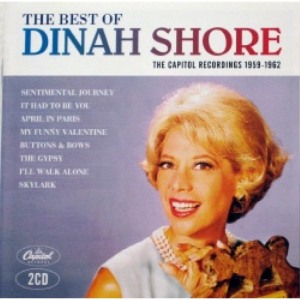
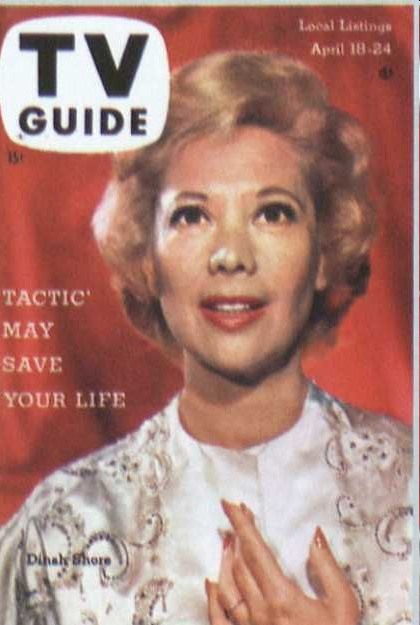
She’d ended every show with her unforgettably perky version of the theme song “See the USA in Your Chevrolet!”
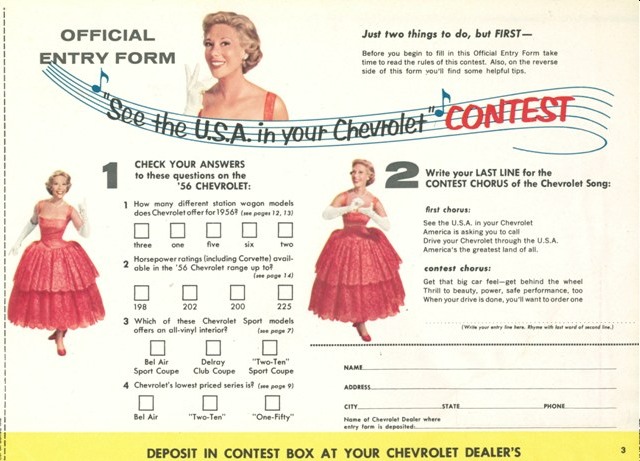
If you’re way too young to remember her show, or if you are old enough to have nostalgia about it, click on the Play button below and get just a tiny taste of her girl-next-door simple, sentimental sweetness in a short clip from a January 1952 Dinah Shore Show.
Yes, if all you ever saw of TV musical variety show entertainment in the early to mid-50s was old clips of the Dinah Shore Show, you’d surely be convinced that public taste was indeed very respectable and genteel in those Clean Good Old Days.
But don’t dig too deeply on Youtube for samples of 50s popular entertainment or your bubble might be burst…for instance, when you stumbled across the other main female variety show star of the era…Dagmar.
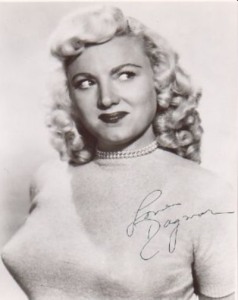
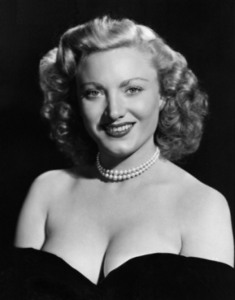
Dagmar’s name was indelibly connected with automobiles too. But not in the way Dinah’s was. To this day, “vintage car” aficionado guys are enthused to appreciate autos from the Fabulous Fifties with… Dagmar Bumpers.
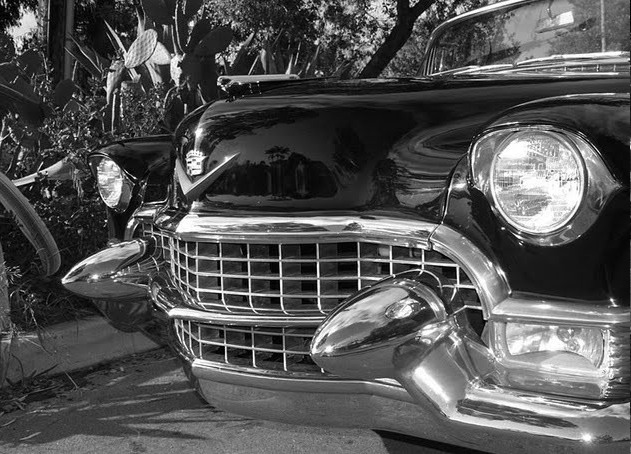
Dagmar bumpers is a slang term for chrome conical shaped styling elements which began to appear on the front bumper/grille assemblies of certain American automobiles following World War II. They reached their peak in the mid-1950s.
The term is derived from the notable physical attributes of Dagmar, a buxom early 1950s television personality known for low-cut gowns and pronouncedly conical bra cups. She was amused by the tribute.
As originally conceived by Harley Earl, GM Vice President of Design, the conical bumper guards would mimic artillery shells. Placed inboard of the headlights on front bumpers of Cadillacs, they were intended to both convey the image of a speeding projectile and protect vehicles’ front ends in collisions.
As the 1950s wore on and American automakers’ use of chrome grew more flamboyant, they grew more pronounced.
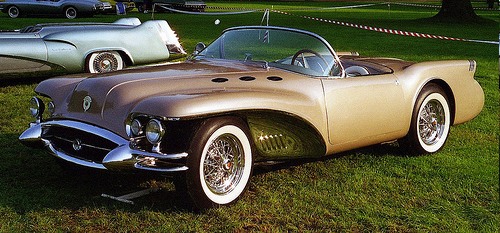

The black rubber tips they gained on the 1957 Cadillac Eldorado Brougham and other models were known as pasties. [As seen in the pic below…if you aren’t familiar with the term, pasties are what burlesque show strippers wore on the tips of their breasts in situations where laws forbade fully topless “entertainment.” ] (Source)

Looks like some car owners were even inclined to embellish their Dagmar Bumpers’ pasties with another accessory common to burlesque shows… tassels.
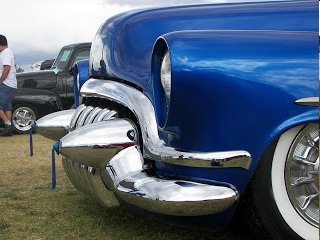
Yes, at the exact same time that TV audiences were all ga-ga over Dinah Shore’s demure persona and modest wardrobe, a huge proportion of those same audiences were equally ga-ga over Dagmar’s…alternative attributes.
But just who was Dagmar?
Her real name was Virginia Egnor Lewis. Born in 1921 in West Virginia, she had married and moved to New York in 1941. For the next decade she had various jobs in modeling and minor roles in Broadway productions. Then TV burst on the scene. One of the earliest comedy-variety shows on NBC was a late-night show called Broadway Open House, which debuted in 1950 hosted by popular MC Jerry Lester. One of the people he hired for the cast of the new show was Virginia.
… [Lester] renamed her Dagmar. …As Dagmar, Lewis was instructed to wear a low-cut gown, sit on a stool, and play the role of a stereotypical dumb blonde. With tight sweaters displaying her curvy 5′ 8″ figure (measuring 42″-23″-39″), her dim-bulb character was an immediate success, soon attracting much more attention than Lester. Lewis quickly showed that regardless of appearances, she was quite bright and quick-witted. She appeared in sketches, and Lester made occasional jokes about her “hidden talents”.
Her appearances created a sensation, leading to much press coverage and a salary increase from $75 to $1,250. With Dagmar getting all the attention, Lester walked off his own show in May 1951, and Dagmar carried on as host. On July 16, 1951, she was featured on the front cover of Life, and the show came to an end one month later.
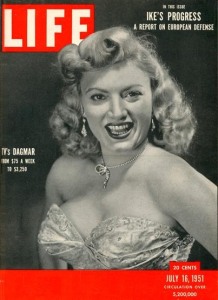
LIFE proclaimed Dagmar to be “a national institution.” And a 1950s poll of editors voted her to be “the most photogenic girl on TV.”
I don’t doubt Virginia Egnor Lewis was a bright woman, comedically talented. But it would be naïve in the extreme to assume that her popularity would have been the same without her decidedly un-Dinah-Shoreish, Dagmar Bumper characteristics.
Dagmar became one of the leading personalities of early 1950s live television, doing sketch comedy on Milton Berle’s Texaco Star Theater, the Bob Hope Show, and other shows.
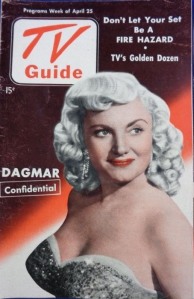
In 1952, she hosted the short-lived, late Saturday evening Dagmar’s Canteen (which aired on NBC at 12:15 am Eastern Time, unsponsored), in which she sang, danced, interviewed servicemen, and performed comedy routines. The basic premise of the show was that servicemen from the audience were given roles to act alongside Dagmar in sketches. [Source]
Click on the PLAY button below to juxtapose Dinah Shore’s demure TV performance of “It’s a Lovely Day,” shown in the clip above, with a much less demure performance by Dagmar , also in 1952, of song titled “Ballin’ the Jack” on her Canteen show.
I think many Baby Boomers around my age (I was five years old when the Dinah Shore Show started) look back on their childhoods with either “blinders” on their memories that allow them to see only a very narrow field of vision of the past…
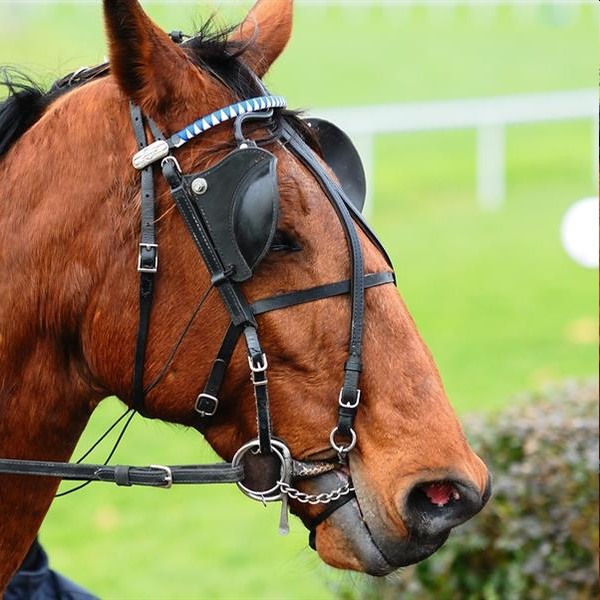
…or wearing “Rose-Colored Nostalgia Glasses”! Glasses that can even make bleakness look rosy.

Part of the problem is perhaps that they WERE young children during those early and mid 1950s. They weren’t adults or even teens, and thus a lot of the strong sexual “innuendo” on TV, such as in Dagmar’s performances, was lost on them. And of course, their parents would have not taken them to adult-themed movies.
Unless they were nosy like I was (poking around in closets and drawers in their dad’s bedroom…), they also wouldn’t have discovered that their Happy Days Era Dad may well not have been as pure-of-mind and heart as Richie Cunningham’s dad Howard…for after all, Playboy magazine wasn’t invented in the Swingin’ Sixties, a product of the supposed slide into sleaziness invited by the Supreme Court school decisions. Its first issue, with a totally full-frontal nude centerfold of Marilyn Monroe from a 1949 photo-shoot, came out in 1953!
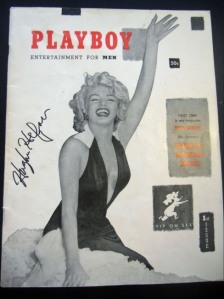
And then there were these ads, part of a series promoting, of all things, Griffin shoe polish (!) from magazines in 1956-1958.
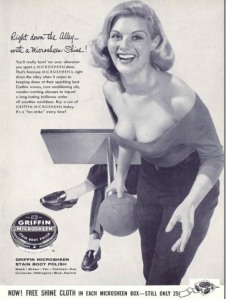
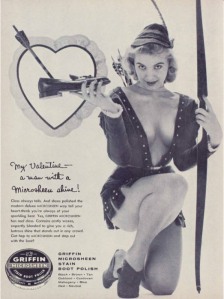
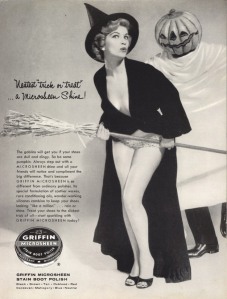
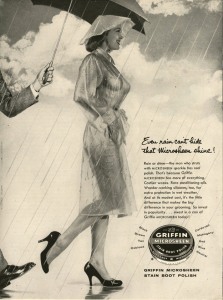
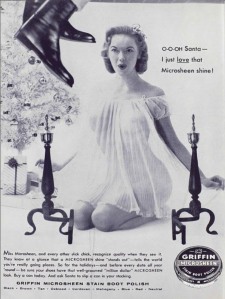
I suppose those ads didn’t show up in the Saturday Evening Post, but were created for the burgeoning “men’s magazine” trade of that time. And Griffin wasn’t the only company that understood that sex sells just about anything…
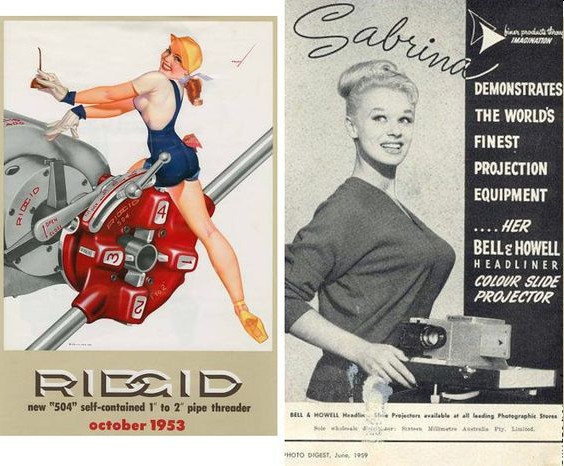
I had no clue who “Sabrina” was until looking her up on Wiki just now. She was evidently a 1950s British version of Dagmar. As the ad claims above, she used her “projection equipment” to sell projection equipment. Among lots of other things.
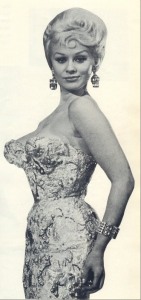
Norma Ann Sykes (born 19 May 1936), better known as Sabrina, was a 1950s English glamour model who progressed to a minor movie career. Her main claim to fame was her hourglass figure of prodigious 41-inch breasts coupled with a tiny 19-inch waist and 36-inch hips.
Sabrina was one of “a host of exotic, glamorous (British) starlets … modeled on the likes of Marilyn Monroe, Jayne Mansfield and Lana Turner”
Even after all these years, she still has a big fan base on the Internet, including in Australia. I’m assuming many of them are aging Baby Boomer men with misty, water-colored mem’ries of the scantily-clad heroine of their youth. As the online “Encyclopedia Sabrina” website puts it…
Norma Ann Sykes D.Litt (Hon) is the voluptuous British lass who became Sabrina and accomplished above the hips what Elvis accomplished below.
She is the Cheshire cheese-cake pinup, actress, singer, cabaret star, publicity pioneer, and sex-queen who didn’t like to be touched.
She was a ‘dumb blonde’ who was a genius at self-promotion, an ill-educated teenager because of lengthy hospital stays, and an honorary Doctor of Letters with an impossibly-proportioned figure.
A victim of polio, mocked for her lack of talent and excess of bosom, she became an international phenomenon who dated princes; charmed dictators, the public and cynical reporters; and generated more myths, lies, legends and throbbing memories than anyone else of her era.
Sabrina even one-upped Dagmar in getting vehicle parts named after her–“Sabrina’s” were protuding parts of both a British truck…and British Hawker Hunter fighter planes.
Yes, Sabrina was part of that genteel, modest, Christian Era of the 50s too. Of course, this was in Britain, but the UK had long been viewed as being more “dignified” than the US, especially back in those days. And the reality is that Sabrina didn’t come to TV fame until 1955…the US beat UK TV to the punch with Dagmar clear back in 1951. But Sabrina quickly caught up…
If you want to see the first face of modern British celebrity culture you have to go back to the evening of 15 February 1955 and comedian Arthur Askey’s BBC television series Before Your Very Eyes. That night millions of viewers saw something they’d never seen before: television’s first sex symbol in action. She was a young, busty, peroxide blonde in a tight black dress making her television debut. Viewers watched in amazement as she slid off a sofa, walked towards the camera, and then slowly turned sideways to reveal the mountain range of her magnificent cleavage. One can only imagine the effect on the families watching: a collective gasp of wonder. Men would fidget on the settee; teenage boys would blush and women would go and put the kettle on. [Source]
Does anyone have any doubt that she would have had the same effect on men and teen boys in America? Press the PLAY button below and you can get a short glimpse of Sabrina in action, in an ad selling Automotive Lubricants.
Dagmar and Sabrina and all their scantily-clad, excessively endowed sisters were particularly fodder for the “men’s magazines” of that era. I’m suspicious many, if not most, kids’ dads of the time had a stash of these under the bed mattress or in a dresser drawer under their socks. Some of these publications focused on “true” (or pseudo-true) violent war memoir stories, and dangerous outdoor adventure stories with vicious wild animals…with illustrations of half-naked babes thrown in as spice on occasion. Others were more narrowly focused on those half-naked babes in “pin up” poses. The most adventurous such dads may have rushed out to buy Playboy, the “New Guy on the block” in 1953. It had the best in the way of actual photos, especially with that Centerfold.
But it cost a bit more (50 cents), and had all that “intellectual” stuff to actually read if you were so inclined. For 25 cents and less reading effort, anybody’s dad could afford the trashy men’s mags that had sleazy stories and luscious realistic (well, cartoonic reaistic) artwork of scantily clad women. Yes, most weren’t nearly as explicitly raunchy as what men can purchase at Truck Stop magazine stands today—the ones back in the 50s would have been what is now called “soft porn.” But I can guarantee that most would still curl the toes of the average mom in a 21st century evangelical household if she caught her husband or teen sons hiding some under the mattress!
There was Stag magazine, that had been in print since the 1930s.
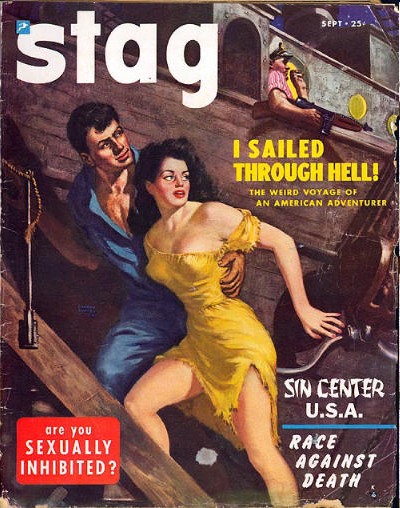
Its publisher successfully sued Hugh Hefner over the name of his planned magazine…Playboy was originally going to be titled Stag Party!
There were many, many of these magazines, with names like TRUE, True Men, Cavalier, For Men Only, Man’s Life, Man’s Action, and on and on and on.
But of course, that’s MEN. Surely at least the women of that era were mostly prim and proper, and uninterested in anything sexual outside of their own marriage?
It’s kind of difficult to maintain that illusion when you consider…Peyton Place.
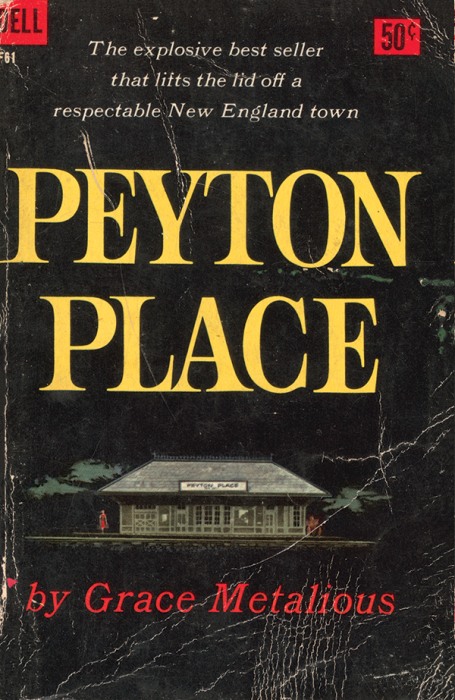
Peyton Place is a 1956 novel by Grace Metalious. The novel describes how three women are forced to come to terms with their identity, both as women and as sexual beings, in a small, conservative, gossipy New England town, with recurring themes of hypocrisy, social inequities and class privilege in a tale that includes incest, abortion, adultery, lust and murder. It sold 60,000 copies within the first ten days of its release and remained on the New York Times best seller list for 59 weeks.
The novel spawned a franchise that would run through four decades. Twentieth Century-Fox adapted it as a major motion picture in 1957, and Metalious wrote a follow-up novel that was published in 1959, called Return to Peyton Place, which was also filmed in 1961 using the same title. The original 1956 novel was adapted again in 1964, in what became a wildly successful prime time television series for 20th Century Fox Television that ran until 1969, and the term “Peyton Place” – an allusion to any small town or group that holds scandalous secrets – entered into the American lexicon. [Source]
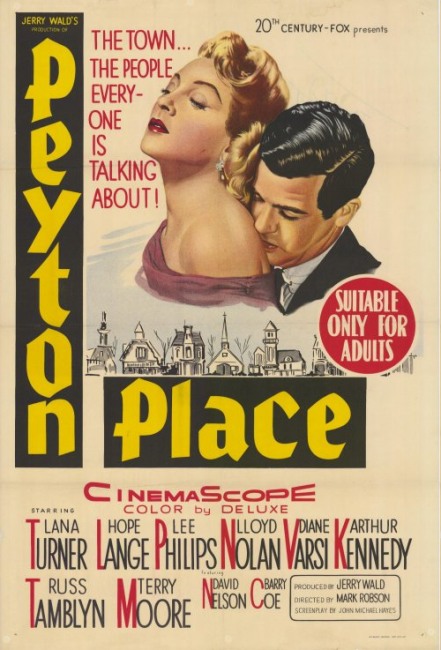
A week before it hit bookstores, on September 24, 1956, it was already on the best-seller list, where it would remain for half a year. In its first month, it sold more than 100,000 copies, at a time when the average first novel sold 3,000, total. It would go on to sell 12 million more, becoming one of the most widely read novels ever published. During its heyday, it was estimated that one in 29 Americans had bought it—legions of them hiding it in drawers and closets due to its salacious content.
I saw one “nostalgia piece” on the Web where a fellow confessed that he and his teenage buddies of that era would sneak their moms’ copies of Peyton Place out of the house, and get together and read the “dirty parts” out loud to each other at all-guy parties. I’m going to guess that this was not unique to just that group of young men. I’ll bet it happened all over the country!
Yes, just like Playboy, the Peyton Place phenomenon was also not spawned by the Sexy Sixties, but by the allegedly prim and proper Fifties. And it would be pathetically naïve to think that those first 100,000 people who read it that first month—and the millions more later—were all men. Sorry, younger generation folks…your grandmas and great grandmas were scooping up their own copy and breathing heavily while reading it too. I was only ten when the first edition came out, so I didn’t get caught up in the first wave of readers. But by 1962 I was 16 and old enough to go out to the bookstore on my own. I bought my own paperback copy (and brought it home and promptly hid it under a chair cushion in my bedroom.)
And why should anyone be surprised that both men and women of the 1950s had salacious interests? Many Boomers look back on the misty mem’ries of movies they saw in the 1950s and tend to remember just Family Friendly ones like Old Yeller and The Ten Commandments and Singin’ in the Rain.
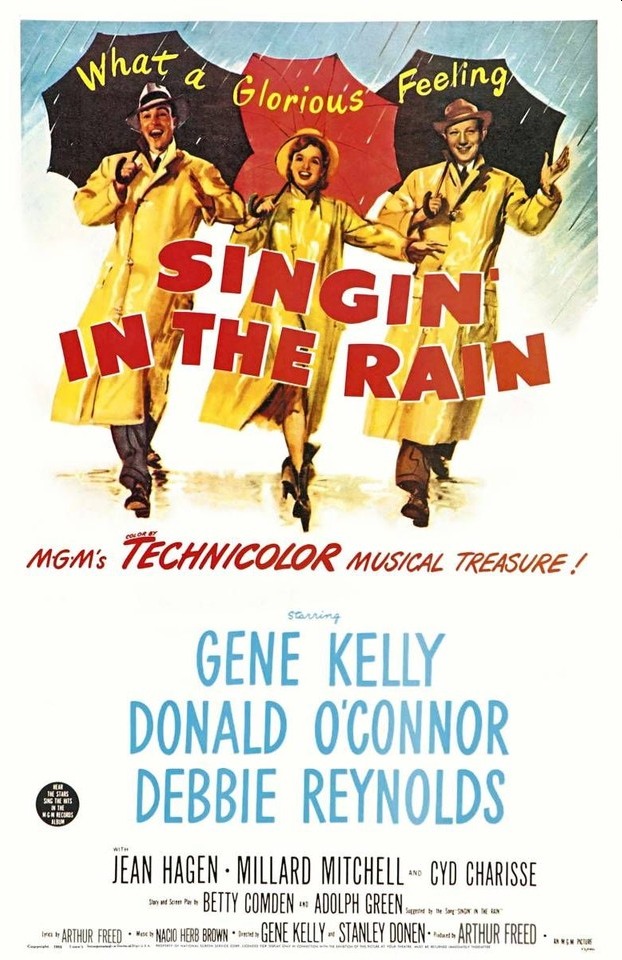
1952
They seem to totally forget hits such as these below, that were loaded with sexual innuendo and scantily clad beauties…
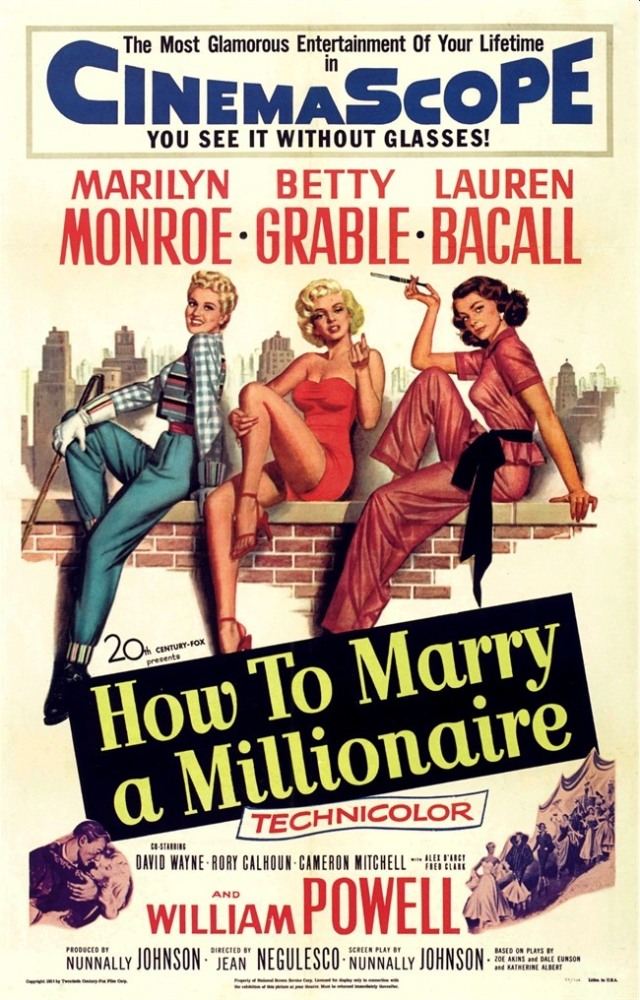
1953
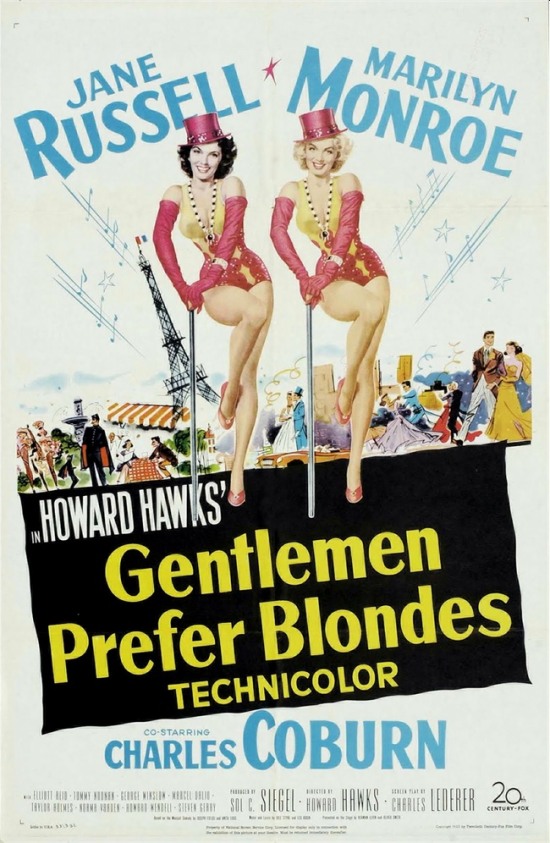
1953
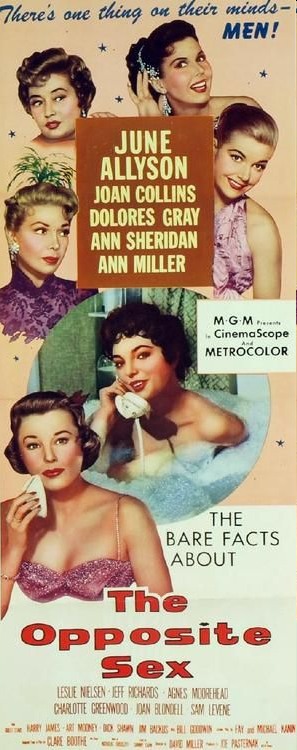
1956
And, as mentioned in an earlier entry in this series, there was a huge spate of sex-themed films in the 50s that were aimed particularly at teens.
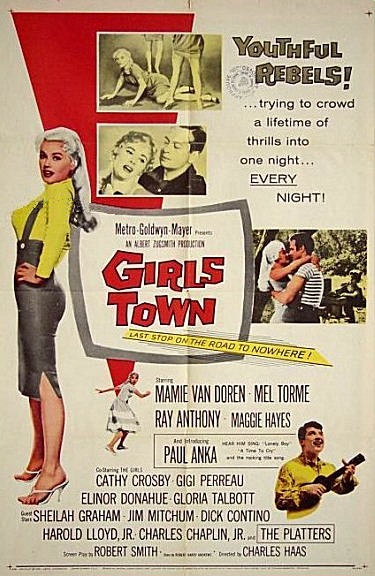
1959
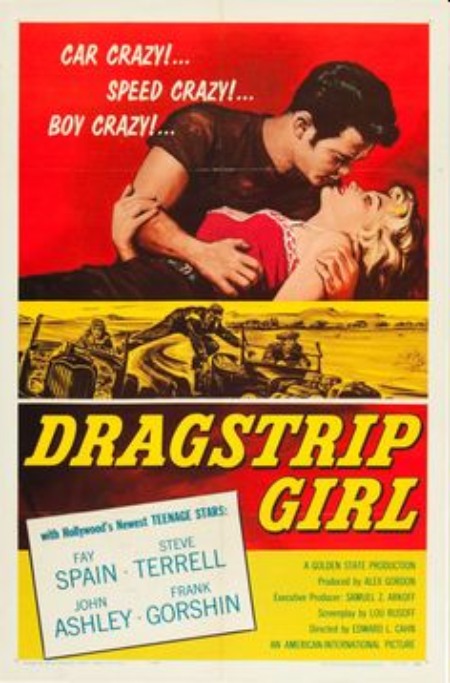
1957
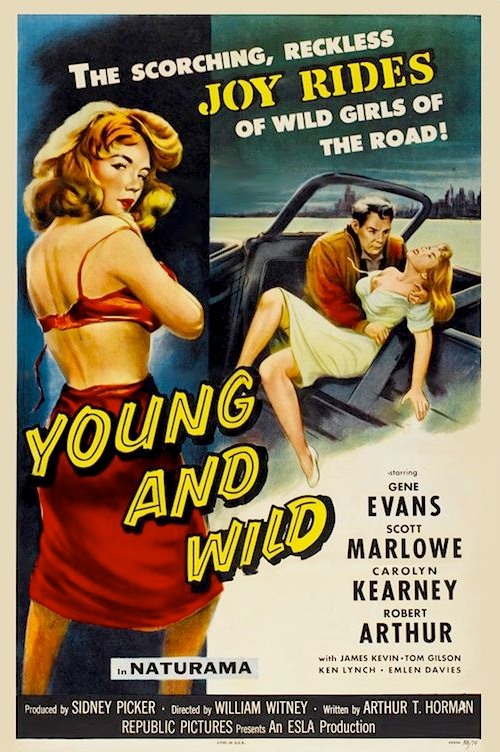
1958
Many later generations of evangelicals seem determined to believe that their own dear ol’ grandad and grandma of the post-war baby boom generation, and great-granddad and great-grandma of the Depression and World War 2 “Greatest Generation,” were perfectly pious adult gentlemen and proper ladies back in the 1950s, because America Was Christian back then. They refuse to even try to imagine that their grandparents or great grandparents might have had lustful interests. Because if that were so…maybe there IS no era that we could “go back to” that was truly pure and pious and great! Maybe we’d have to just realize that human nature has been pretty much the same throughout human history. Maybe every generation has had… The Good, The Bad, and the Ugly. And the Trashy…
In fact, in spite of the huge efforts of the Religion in American Life organization (described in an earlier entry in this series) to make sure everyone went to The Church of Their Choice every Sunday morning, might it be possible that this was the “aim”… but not the reality? Even Norman Rockwell gave a hint of this little secret on a Saturday Evening Post cover in 1957:

And maybe, just maybe, a significant percentage of those who DID go to church on Sunday—under peer pressure, or out of a desire to be part of a social circle that might enhance one’s social status in a community…had spent Saturday night watching a sleazy movie or reading Peyton Place. Attendance at a one hour ritual on one morning a week really is no “proof of piety” at all.
As a matter of fact, even singing innocuous songs on TV for an hour is no particular “evidence” of what a public personality is really like. Take Dinah Shore for instance…I watched her show for several years as a child. But I never saw her like THIS:
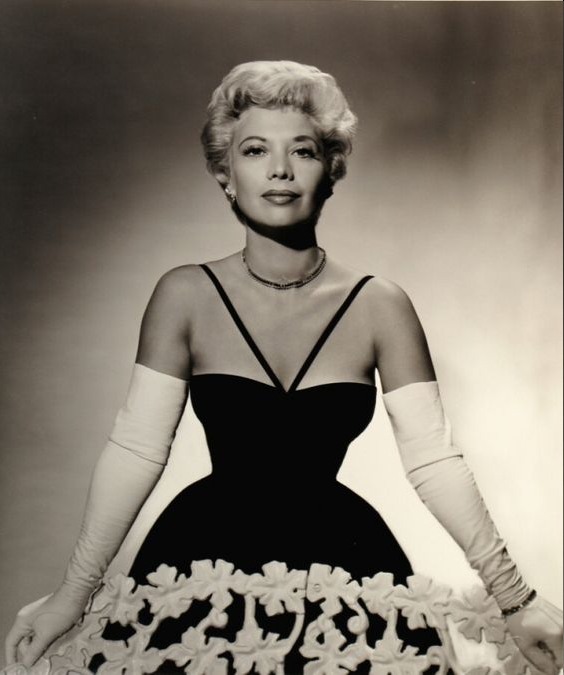
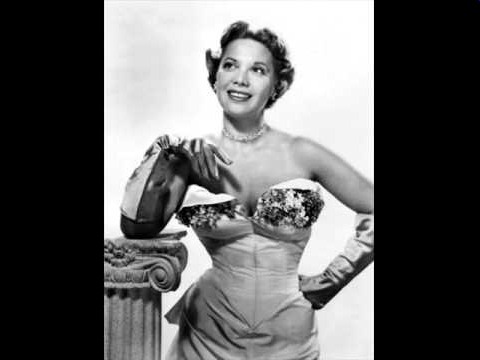
And I never realized until recently what her…ahem…social life out in the real world was like until reading up on her bio recently. Dinah was her stage name. She was actually born “Fannye Rose” to Russian-Jewish immigrant shopkeepers in 1916. After a rough youth including a bout with polio and the death of her mother when she was 16, she broke into show business in New York.
In her early career, while in New York, Shore was briefly involved with drummer Gene Krupa. After Shore relocated to Hollywood, she became involved with James Stewart and it was rumored that a Las Vegas, Nevada, elopement was aborted en route. Shore’s flirtation with General George Patton was commented on when he escorted her for a portion of her tour to entertain the troops in Britain and France during World War II.
Shore was married to actor George Montgomery from 1943 to 1962. She gave birth to daughter Melissa Ann, now known as Melissa Montgomery, in January 1948. She later adopted her son, John David “Jody” Montgomery. The author of Mr. S, Frank Sinatra’s longtime valet George Jacobs, claimed Shore and Sinatra had a long-standing affair in the 1950s. After her divorce from Montgomery, she briefly married Maurice Smith. Romances of the later 1960s involved comedian Dick Martin [of Rowan and Martin’s Laugh-In], singer Eddie Fisher, and actor Rod Taylor.
In the early 1970s, Shore had a long and happy public romance with actor Burt Reynolds who was twenty years her junior. The relationship gave Shore an updated, sexy image, and took some of the pressure off Reynolds in maintaining his image as a ladies’ man.
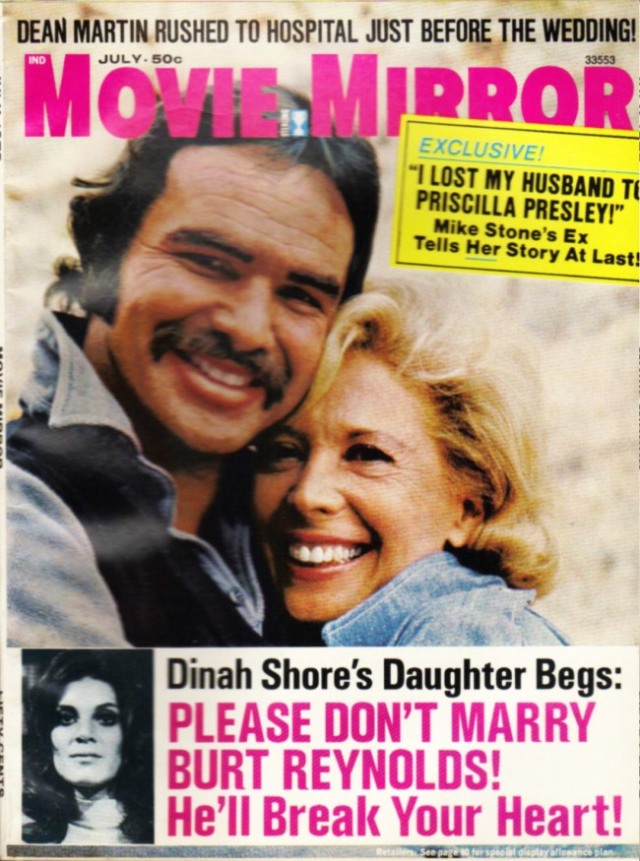
The couple was featured in the tabloids and after the relationship cooled, the tabloids paired Shore with other younger men, including Wayne Rogers, Andy Williams, Iggy Pop and “Tarzan” actor Ron Ely. In her later years, Shore also dated novelist Sidney Sheldon, Dean Martin, and former New York Governor Hugh Carey. [Source]
Yes, Dinah Shore was not actually the prim, proper little lady singing cheery songs that are part of my misty, water-colored mem’ries of the 1950s. That was just a very, very tiny glimpse of a very tiny portion of her life. She was that way for one hour on TV a week for six years. The rest of the time she was not necessarily a role model for every evangelical Christian mama’s daughter! As you can see in this photo, no doubt from the period in which she was involved in a romance with Dick Martin:
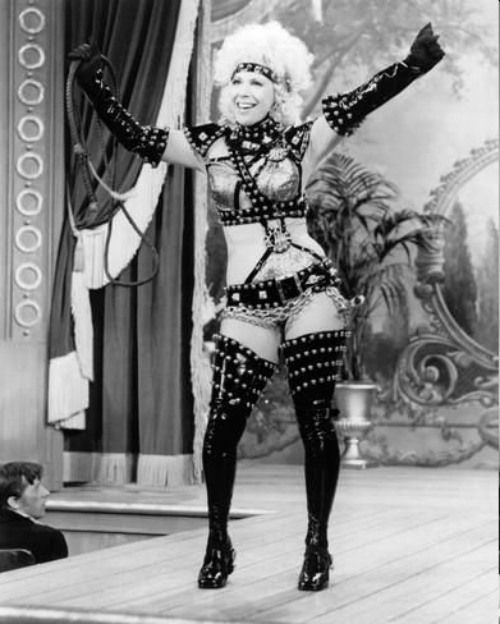
Rowan and Martin’s Laugh In, (Episode 87, February 8, 1971):
“Dinah Shore plays a stripper in a mod salute to the working girl.”
After sorting through the reality behind many of my own memories of the 50s for several years now, through the magic of the huge collection of information, photos, and videos on the Web, I have become convinced that for most of us, that classic song needs a new ending…
Misty water-colored mem’ries
Of the way we WEREN’T
In the next entry in this series, we will explore why it is so important to Donald Trump’s Strangest Bedfellows that they ignore–or refuse to even consider–the reality that America was neither truly great, nor truly “Christian” in the 1950s.